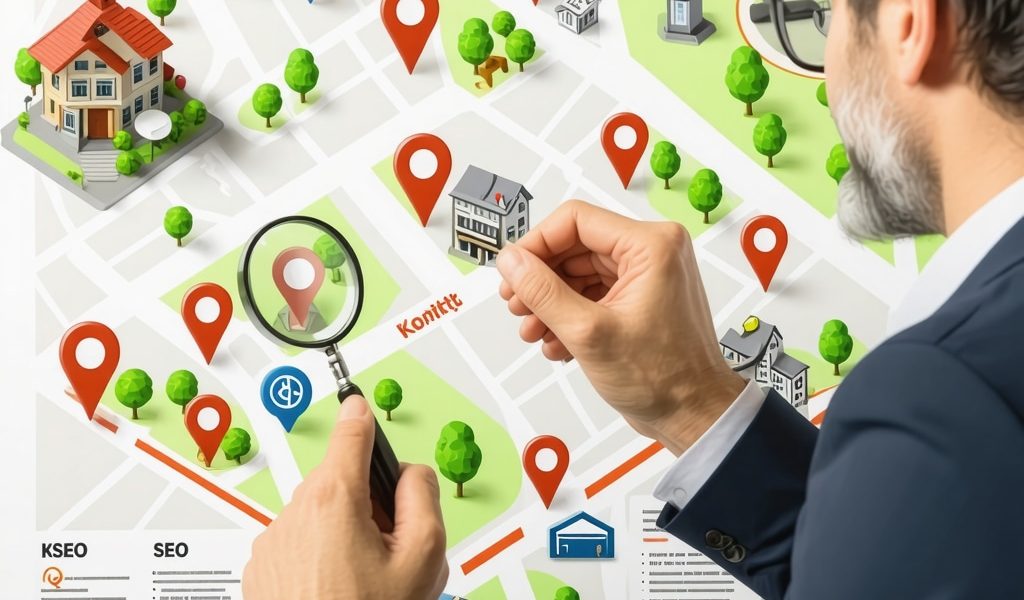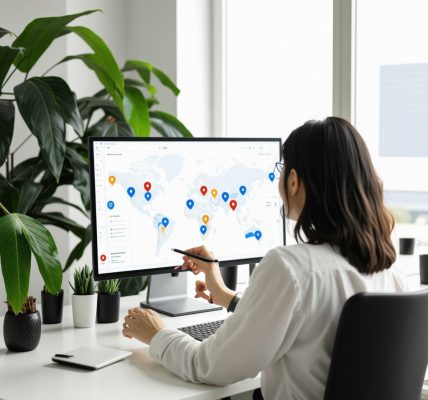Unveiling the Strategic Importance of Hyperlocal SEO in Today’s Competitive Landscape
In an era where consumers increasingly rely on digital search to find immediate, local solutions, hyperlocal SEO emerges as a critical strategy for businesses aiming to dominate their immediate geographic area. Unlike broader local SEO, hyperlocal SEO targets micro-neighborhoods or specific localities, enabling brands to capture nearby clients with high intent and relevance. This nuanced approach demands precision, leveraging localized keywords, Google My Business (GMB) optimization, and tailored content strategies to build authoritative presence within constrained but valuable search radii.
Advanced Techniques for Precision Targeting in Hyperlocal SEO
Leveraging Geo-Intent Keywords and Semantic Search for Neighborhood Domination
Effective hyperlocal SEO hinges on identifying and integrating geo-intent keywords that reflect the vernacular and search patterns of specific communities. Incorporating Latent Semantic Indexing (LSI) keywords related to local landmarks, street names, and colloquial terms enriches content relevance, enabling search engines to associate your business with hyper-specific queries. For instance, instead of generic terms like “plumber in Chicago,” optimizing for “emergency plumbing services near Lincoln Park” enhances visibility where competition is less diluted and user intent is sharper.
How Does Optimizing Google Business Profile Influence Hyperlocal Rankings?
Google Business Profile optimization is paramount in hyperlocal SEO. Rigorous adherence to GMB best practices—such as maintaining consistent NAP (Name, Address, Phone number) data, acquiring geo-targeted citations, and regularly updating posts and photos—elevates trustworthiness and signals active engagement to Google’s algorithms. According to Search Engine Journal’s Local SEO Guide, businesses that optimize their GMB profiles properly see a significant uplift in local pack rankings, especially for “near me” searches, which have surged by over 900% in recent years.
Harnessing User Experience Signals and Behavioral Analytics in Hyperlocal Contexts
Beyond traditional ranking factors, user experience metrics such as click-through rates, dwell time, and bounce rates on hyperlocal landing pages provide critical feedback loops for refining SEO strategies. Employing tools to analyze these behavioral signals enables businesses to tailor content and site architecture to better meet hyperlocal user expectations, thereby reinforcing relevance and authority within micro-markets.
Integrated Content and Citation Strategies to Amplify Local Authority
Robust hyperlocal SEO demands a multi-channel citation management approach. Ensuring your business is consistently listed across localized directories, community websites, and niche citation platforms bolsters domain authority and local relevance. Coupling this with hyperlocal content creation—such as neighborhood guides, local event coverage, and customer testimonials—creates a comprehensive ecosystem that signals deep community integration to search engines.
Explore more expert strategies on mastering hyperlocal SEO and boosting your local reach to gain actionable insights from proven methodologies.
What Metrics Best Measure the Success of Hyperlocal SEO Campaigns?
Determining the effectiveness of hyperlocal SEO requires nuanced analytics beyond standard traffic metrics. Key performance indicators (KPIs) include increased visibility in localized SERPs, growth in “near me” queries, improvements in GMB insights such as calls and direction requests, and conversion rates from hyperlocal landing pages. Utilizing GMB analytics and tools like BrightLocal or Moz Local can provide granular data to iteratively optimize campaigns.
For a comprehensive understanding of utilizing GMB data to empower local business growth, visit this detailed guide.
Call to Action: Elevate Your Hyperlocal SEO Mastery
To deepen your expertise and refine your hyperlocal SEO tactics, engage with our advanced resources and join the community of professionals elevating local search performance. Share your unique challenges and solutions to contribute to the evolving discourse around hyperlocal marketing strategies.
Integrating Behavioral Analytics to Refine Hyperlocal SEO Strategies
Understanding user behavior within hyperlocal contexts offers a competitive edge for businesses aiming to dominate micro-markets. By analyzing metrics such as click-through rates, heatmaps, and conversion funnels on neighborhood-specific landing pages, marketers can identify friction points and opportunities for content enhancement. For example, a sudden drop in dwell time might indicate content misalignment with user intent, prompting targeted adjustments to better reflect local vernacular or needs. Tools like Google Analytics and Hotjar empower businesses to gather these actionable insights, enabling continuous optimization.
Moreover, integrating behavioral data with Google Business Profile performance metrics—such as direction requests and call clicks—provides a holistic view of customer engagement across platforms. This synergy informs strategic decisions, from adjusting service descriptions to refining geo-targeted ad campaigns, effectively bridging online signals with offline conversions.
Advanced Citation Management: Building Trust and Authority in Hyperlocal Niches
Hyperlocal SEO success hinges on authoritative citation management. Beyond ubiquitous directories, identifying and securing listings on hyperlocal and niche-specific platforms consolidates your business’s digital footprint within the community. Consistency in NAP data across these citations is crucial to maintain trustworthiness and avoid algorithmic penalties. Employing automated citation tracking tools can streamline this process, alerting businesses to discrepancies for swift resolution.
Furthermore, strategic use of community partnerships and sponsorships offers opportunities to earn valuable backlinks and citations, enhancing domain authority. For instance, sponsoring local events or charities can result in mentions across community websites and local news outlets, amplifying your hyperlocal SEO efforts organically.
For practical frameworks on citation management tailored to hyperlocal SEO, consider exploring these expert citation management techniques that strengthen local search rankings effectively.
What Role Does Mobile Optimization Play in Enhancing Hyperlocal SEO Performance?
With the majority of “near me” searches conducted via mobile devices, ensuring seamless mobile user experiences is paramount for hyperlocal SEO. Mobile optimization encompasses fast load times, intuitive navigation, and location-aware functionalities like click-to-call and map integrations. Google’s mobile-first indexing prioritizes sites that deliver superior mobile performance, directly influencing local pack rankings.
Implementing Accelerated Mobile Pages (AMP) for hyperlocal content and leveraging responsive design principles reduces bounce rates and elevates user engagement, reinforcing Google’s signals of relevance and authority within micro-local searches.
According to Moz’s Local SEO Guide, businesses that optimize for mobile see a substantial uplift in local search visibility and customer conversions, underscoring mobile optimization as a non-negotiable pillar of hyperlocal SEO strategy.
Explore our complete guide on mastering Google Business SEO to harness mobile optimization techniques effectively and boost your local presence.
Engaging with the Community: A Call to Action for Hyperlocal SEO Excellence
We invite SEO professionals and business owners alike to share their experiences and innovative tactics for hyperlocal SEO in the comments below. Engage with peers to exchange insights on emerging trends, challenges, and solutions that drive local digital dominance. Additionally, share this article with your network to foster a community dedicated to mastering hyperlocal SEO.
Behavioral Analytics Integration: Decoding Micro-Market User Intent for Strategic Hyperlocal SEO Enhancements
Delving deeper into behavioral analytics unveils a sophisticated layer of hyperlocal SEO strategy, where understanding the nuanced actions of hyperlocal users becomes transformative. By deploying advanced tools like heatmapping alongside session recordings, businesses can discern exactly how users interact with hyperlocal content—identifying hotspots of engagement and areas triggering friction. For example, in a neighborhood-specific webpage for a boutique coffee shop, analyzing scroll depth and click patterns reveals if visitors are drawn to the menu, promotional offers, or community event announcements. This granular insight enables hyperlocal brands to dynamically adapt their content hierarchy and call-to-action placements, optimizing for conversion and user satisfaction.
Further, coupling these insights with predictive analytics models can forecast user behaviors within a micro-geography, allowing marketers to preemptively tailor content and offers that resonate on an anticipatory level. This proactive approach to hyperlocal SEO not only boosts engagement metrics but also fortifies the business’s positioning as an intuitive, community-attuned service provider.
How Does Behavioral Analytics Influence Conversion Optimization in Hyperlocal Campaigns?
Behavioral analytics uncovers the decision-making journey of hyperlocal users, identifying key drop-off points and conversion catalysts. By tracking micro-conversions such as clicks on “Get Directions” or “Call Now” buttons, businesses can optimize landing pages to reduce friction and enhance user flow. For instance, A/B testing different contact form layouts or localized testimonials can reveal what elements best inspire trust and action among neighborhood clientele.
Integrating these data-driven refinements with real-time Google Business Profile interactions creates a feedback loop that accelerates continuous improvement, ensuring that hyperlocal SEO efforts translate directly into measurable business results.
Hyperlocal Citation Networks: Architecting Trust Through Niche and Community-Driven Backlinks
Beyond standard citations, constructing a web of hyperlocal backlinks from authoritative neighborhood blogs, local news outlets, and community bulletin boards is a potent strategy to amplify SEO authority. These citations function not only as trust signals to search engines but also as genuine endorsements within the community fabric, enhancing brand credibility.
Strategic partnerships—such as collaborations with local artisans, sponsorship of micro-events, or guest blogging on hyperlocal platforms—enable businesses to embed themselves authentically in the digital ecosystem of their area. Employing tools like Ahrefs or SEMrush to audit backlink profiles helps ensure that these links are high-quality and contextually relevant, thus maximizing their SEO impact.
Mobile-First Hyperlocal SEO: Designing Seamless Location-Aware Experiences for the On-the-Go Consumer
As mobile devices dominate local search traffic, hyperlocal SEO success increasingly hinges on delivering frictionless, location-aware experiences. Incorporating progressive web app (PWA) technology enhances site speed and offline accessibility, critical for users navigating urban micro-environments with variable connectivity.
Additionally, integrating geofencing capabilities enables hyperlocal marketers to trigger personalized notifications, offers, or content when users enter defined neighborhood boundaries, bridging digital marketing with real-world contexts. This synergy fosters heightened engagement and drives foot traffic, a key metric in hyperlocal commercial success.
Google’s mobile-first indexing mandates that mobile versions of websites be fully optimized—not just responsive—to achieve peak rankings. This includes optimizing images for mobile devices, minimizing JavaScript render-blocking, and ensuring fast server response times.
According to a recent BrightLocal Local Consumer Review Survey 2023, 87% of consumers use mobile devices to find local businesses, underscoring the imperative for mobile-centric hyperlocal SEO strategies.
To explore cutting-edge mobile optimization techniques tailored for hyperlocal SEO, consult our comprehensive Google Business SEO guide.
Elevating Hyperlocal SEO Through Artificial Intelligence and Predictive Behavior Analysis
In the evolving hyperlocal SEO landscape, harnessing Artificial Intelligence (AI) to analyze granular user behaviors offers unparalleled strategic advantages. Machine learning models can process voluminous interaction datasets—such as clickstreams, dwell times, and voice search queries—to predict hyperlocal user intent with higher accuracy. This predictive capability allows marketers to preemptively tailor content, promotional offers, and service availability aligned with micro-geographic demand fluctuations, thereby maximizing engagement and conversion.
Semantic Enrichment: Utilizing Knowledge Graphs for Hyperlocal Contextualization
Integrating knowledge graph data into hyperlocal SEO strategies enriches semantic relevance and contextual association. By embedding structured data markup—such as Schema.org’s LocalBusiness and Event schemas—businesses can facilitate enhanced search engine understanding of hyperlocal nuances, including proximity, service specifics, and community affiliations. This semantic layering supports voice assistants and AI-powered search queries, enabling more precise local intent matching and richer search result features.
How Can AI-Driven Personalization Transform Hyperlocal Customer Engagement?
AI-driven personalization leverages behavioral analytics to deliver dynamically customized user experiences in hyperlocal contexts. Through real-time adaptation of landing page content, personalized recommendations based on prior micro-location interactions, and geo-fenced push notifications, businesses can significantly boost conversion metrics. For example, a retail store might dynamically showcase inventory availability tailored to the user’s specific neighborhood demand patterns, enhancing relevance and immediacy.
According to Forbes’ insights on AI in Local SEO, integrating artificial intelligence into hyperlocal strategies not only improves search rankings but also fosters deeper customer relationships through contextual engagement.
Advancing Mobile UX with Progressive Web Apps and Location Intelligence
Progressive Web Apps (PWAs) are revolutionizing mobile user experience for hyperlocal audiences by combining native app capabilities with web accessibility. Their offline functionality, rapid load times, and push notification features create seamless engagement cycles, particularly in areas with inconsistent connectivity. When integrated with advanced location intelligence, PWAs can trigger hyper-relevant content or offers as users traverse specific neighborhood boundaries, effectively bridging digital presence with physical locality.
Moreover, implementing geospatial analytics within PWAs enables marketers to refine user journeys, optimizing touchpoints for maximum conversion according to real-time movement patterns.
Orchestrating Hyperlocal SEO Campaigns with Multi-Channel Attribution Models
To accurately assess the ROI of hyperlocal SEO efforts, deploying sophisticated multi-channel attribution models is imperative. These models attribute conversions across various touchpoints—including organic search, GMB interactions, social media engagements, and localized paid campaigns—offering a holistic view of campaign efficacy. Leveraging tools such as Google Analytics 4’s enhanced measurement and AI-powered attribution insights ensures that resource allocation maximizes impact within micro-markets.
Enriching Citation Ecosystems with Community-Driven Content and Interactive Features
Beyond static citations, embedding interactive community-driven content—such as user-generated reviews, local Q&A, and neighborhood forums—within citation platforms enhances engagement and signals authentic local authority to search engines. Coupling this with real-time business updates and event integrations advances the dynamic nature of citations, fostering trust and continual relevance.
What Emerging Technologies Will Define the Future of Hyperlocal SEO?
Emerging technologies such as augmented reality (AR), voice commerce, and blockchain-based trust signals are poised to reshape hyperlocal SEO paradigms. AR enables immersive neighborhood explorations and virtual try-ons linked to local business offerings, while voice commerce accelerates frictionless purchasing through conversational interfaces optimized for micro-geographies. Blockchain applications could validate citation authenticity and customer reviews, enhancing trustworthiness in hyperlocal ecosystems.
Engage with Cutting-Edge Hyperlocal SEO Innovations
We encourage industry professionals and business leaders to immerse themselves in these advanced methodologies and emerging technologies reshaping hyperlocal SEO. Share your pioneering tactics, experimental results, and questions to collectively push the frontier of location-based digital marketing excellence.

Expert Insights & Advanced Considerations
Harness Behavioral Analytics to Anticipate Micro-Market Needs
Leveraging granular behavioral data such as click patterns, dwell time, and heatmaps on hyperlocal landing pages empowers marketers to decode nuanced user intent within specific neighborhoods. This precision enables anticipatory content adjustments that enhance conversion rates and deepen community resonance, elevating your hyperlocal SEO effectiveness beyond traditional tactics. For an advanced approach, integrating these insights with Google My Business analytics creates a powerful feedback loop to optimize local engagement.
Strategic Citation Ecosystems Drive Local Authority and Trust
Beyond ubiquitous directory listings, cultivating niche hyperlocal citations through partnerships with community blogs, local news outlets, and event sponsorships significantly boosts domain authority and local trustworthiness. Maintaining consistent NAP data across these platforms is critical to avoid algorithmic penalties. Tools and frameworks detailed in expert citation management techniques streamline this process for sustained SEO impact.
Mobile-First Experiences are Non-Negotiable for Hyperlocal Success
With the majority of “near me” searches originating on mobile devices, optimizing for fast loading, intuitive navigation, and location-aware features is imperative. Incorporating Progressive Web Apps (PWAs) and geofencing enhances user engagement by delivering timely, contextually relevant content. Advanced mobile optimization strategies, including those covered in the comprehensive Google Business SEO guide, ensure your business remains highly visible and accessible to on-the-go consumers.
AI-Powered Personalization Elevates Hyperlocal Engagement
Artificial intelligence facilitates dynamic content personalization by analyzing micro-geographic user behaviors and predicting intent with high accuracy. This enables real-time adaptation of offers, inventory displays, and messaging tailored to neighborhood preferences, significantly enhancing conversion potential. Insights from Forbes on AI in local SEO highlight the transformative impact of these technologies on hyperlocal customer relationships.
Curated Expert Resources
- Search Engine Journal’s Local SEO Guide: An authoritative resource detailing foundational and advanced local SEO tactics, essential for mastering hyperlocal optimization nuances.
- RankingSEOgmb’s Master Hyperlocal SEO Guide: Offers deep dives into neighborhood-specific keyword strategies and citation management to boost local reach effectively (link).
- Moz’s Local SEO Guide: Comprehensive insights on mobile optimization and local search ranking factors, critical for mobile-first hyperlocal strategies.
- BrightLocal Local Consumer Review Survey 2023: Provides data-driven analysis on consumer behavior trends emphasizing mobile search dominance and local business discovery.
- Forbes AI in Local SEO Insights: Exploration of AI-driven personalization and predictive modeling transforming local marketing effectiveness.
Final Expert Perspective
Mastering hyperlocal SEO today demands a synthesis of behavioral analytics, authoritative citation ecosystems, mobile-first design, and AI-driven personalization. These advanced strategies collectively empower businesses to transcend generic local SEO, fostering genuine neighborhood engagement and superior search visibility. As hyperlocal search intent grows increasingly sophisticated, investing in these nuanced techniques will be vital for sustained growth and competitive differentiation.
To further refine your hyperlocal SEO expertise, consider exploring our master hyperlocal SEO guide and engage with the professional community to share insights and challenges. Your commitment to these advanced approaches will position your business as a dominant local authority in an ever-evolving digital landscape.

